 |
| @International Exchange with Bahcesehir University in Turkey@ |
|
Graduate school, Department of Architecture
Inter Cultural Studies of Architecture (ICSA) in Istanbul 2012
Thursday, September 27 - Saturday, October 13
|
|
Our faculty of architecture implements e6-year education for architects' to facilitate the graduate school to conduct continuous 6-year education, which satisfies the criteria of JABEE (Japan Accreditation Board for Engineering Education), and UIA (International Union of Architects). Through the system a character with deep insight for diversified life styles and cultures of the world will be nurtured to be a future architect who can take an active part internationally. Based on the general exchange agreement between Mukogawa Women's University (MWU) and Bahcesehir University (BU), Turkey, signed in December 2008, first grade master's course students had practical training on conservation and restoration in the projects prepared by BU in 2010 and 2011. In 2011, 13 first graders in the master's course followed up with the similar practice for 17 days (Thursdey, Sept. 27 - Saturday, Oct. 13).
Leading professor: Associate Professor Toshitomo Suzuki and Assistant Aya Yamaguchi
|
|
| Schedule |
|
Thursday,
September 27,
2012
|
|
Departure from Kansai International Airport
|
|
|
|
|
Friday,
September 28
|
|
Arrival at Istanbul Ataturk Airport
Visit to Bahcesehir University
|
|
|
|
|
Saturday,
September 29
|
|
Historic Areas of Istanbul tour: Hagia Sophia, Blue Mosque etc.
|
|
|
|
|
Sunday,
September 30
|
|
Edirne tour: @Selimye Mosque etc.
|
|
|
|
|
Monday,
October 1
|
|
Conservation and restoration training at the ateliers in Yildiz Palace
|
|
|
|
|
Tuesday,
October 2
|
|
Visited Dolmabah?e Palace and its atelier in Istanbul |
|
|
|
|
Wednesday,
October 3
|
|
Practical training at the Glass Furnace in Istanbul |
|
|
|
|
Thursday,
October 4
|
|
Cappadocia tour: Goreme open air museum etc.
|
|
|
|
|
Friday,
October 5
|
|
Cappadocia tour
Visited the Yassihoyuk excavation site and the Japanese Institute of Anatolian Archaeology (JIAA) |
|
|
|
Saturday,
October 6 |
|
Visit to Kaman Kalehoyuk Archeological Museum
Institute of Anatolian Archeology; Kalehoyuk site
|
|
|
|
Sunday,
October 7 |
|
Buyuk Island tour: visit to Greek Orphanage etc.@
|
|
|
|
|
Monday,
October 8
|
|
Bursa tour |
|
|
|
Tuesday,
October 9 |
|
Workshop at the tile atelier, Izunik Foundation
Visit to wooden architecture in Soloz and Cumalikizik village
|
|
|
|
Wednesday,
October 10 |
|
Practical training of preservation and restoration work at KUDEB |
|
|
|
Thursday,
October 11 |
|
Preparation for the sketch exhibition
Istanbul tour |
|
|
|
Friday,
October 12 |
|
Commemorative sketch exhibition hICSA in Istanbul 2012h
Leave Istanbul Ataturk Airport |
|
|
|
Saturday,
October 13 |
|
Arrive at Kansai International Airport
|
|
|
|
Friday, October 12 - Saturday, October 13, 2012
Sketch exhibition ,
Homecoming |
|
 |
| On the shore of Ortakoy |
|
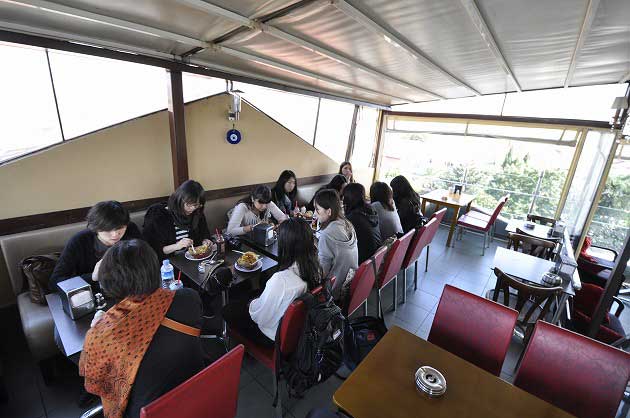 |
Lunch at an Ortakoy restaurant
Enjoying Kumpil (Mixed unpeeled potato and cheese eaten with toppings) |
|
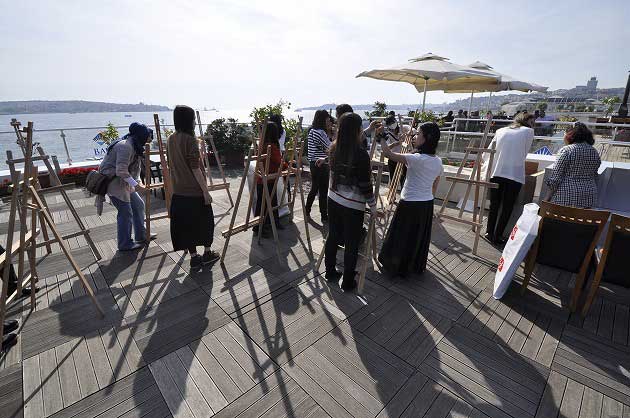 |
| Setting up for the sketch exhibition |
|
 |
| Display at the sketch exhibition |
|
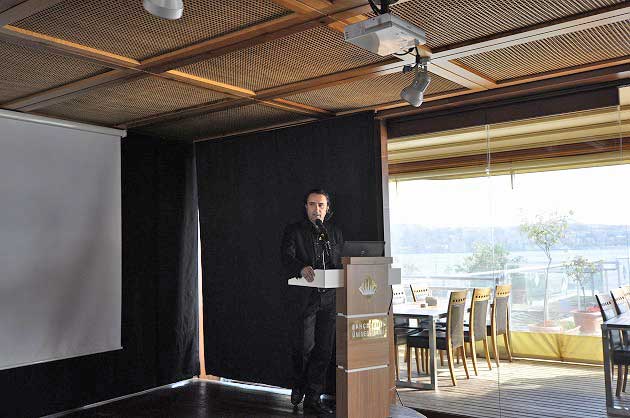 |
| Sketch exhibition
Briefing on the exhibition by Vice Dean Dr. Murat Dundar
|
|
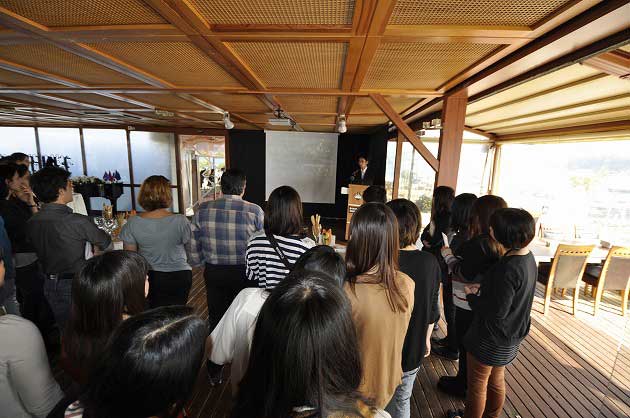 |
| Briefing on the ICSA program by Associate Prof. Dr. Suzuki |
|
 |
| Representational statement of impression of the training by the students |
|
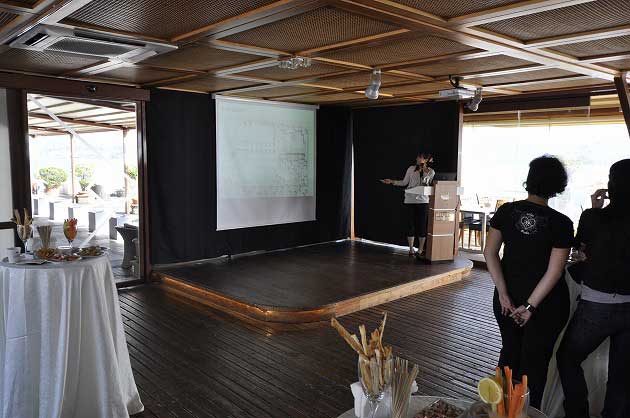 |
| Presentation of past design works by all the participating students |
|
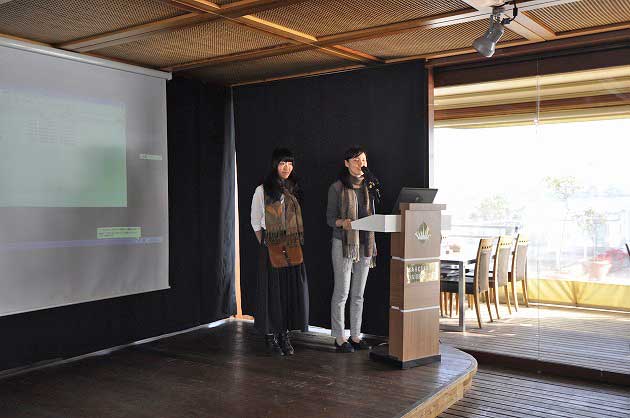 |
| An address of thanks by the two representative students |
|
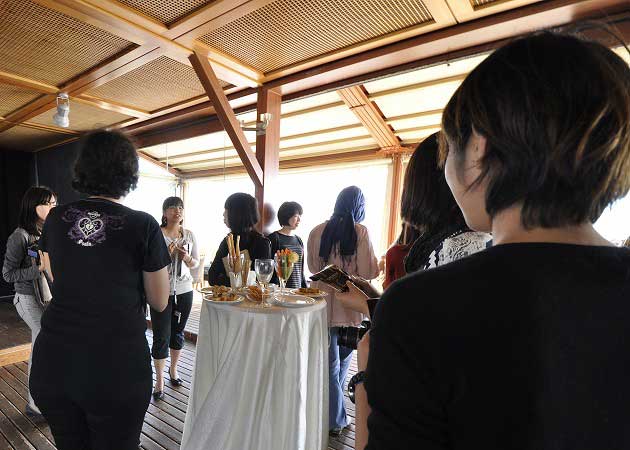 |
| Having a pleasant talk |
|
 |
| Handing gifts to Vice Dean Dr. Murat Dundar, Research Assistants Sinem Kultur and Belinda Torus thanking for their help |
|
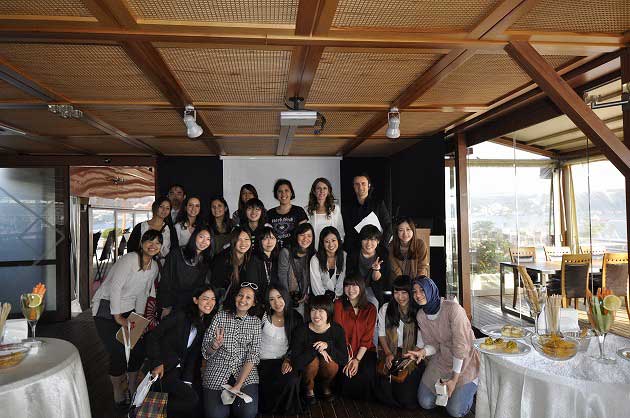 |
| Commemorative photo to conclude the sketch exhibition |
|
 |
| After arriving at the Ataturk Airport, students gave an appreciation gift to the bus driver for his 2-week's service |
|
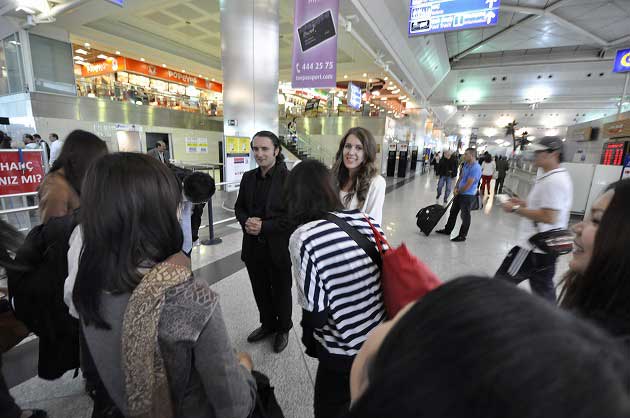 |
| Bidding farewell at the embarkation gate to Vice Dean Dr. Murat Dundar and Research Assistant Sinem Kultur |
|
In the morning we spent walking and sketching along the seashore and visiting a caf? in Ortak?y led by Vice Dean Dr. Murat D?ndar. Having had lunch we returned to the university and set up and opened the sketch exhibition. We had many visitors at the exhibition including Dean Prof. Dr. Ahmet Ey?ce, Dr. Murat and Research Assistants Sinem K?lt?r and Belinda Torus (the three people who led us during our stay) as well as the students who have participated in ICSA in Japan 2012. The exhibition started with a briefing by Dr. Murat followed by salutation by Associate Professor Suzuki. At first he referred to an outline of MWU's Department of Architecture, Graduate School of Architecture Major and the present program. Then three representative students stated our impression of the present practical training. And 13 students, one by one, made a presentation of the design works of their own they had done so far. Then two students expressed our appreciation for the help on behalf of us all. Then we exchanged each other. After the exhibition we moved right away to the airport to return home.
|
|
|
|
Thursday, October 11, 2012
Preparation for the sketch exhibition,
Visit to Uskudar, Eyup, Galata Tower |
|
 |
| Preparation for the sketch exhibition in BU |
|
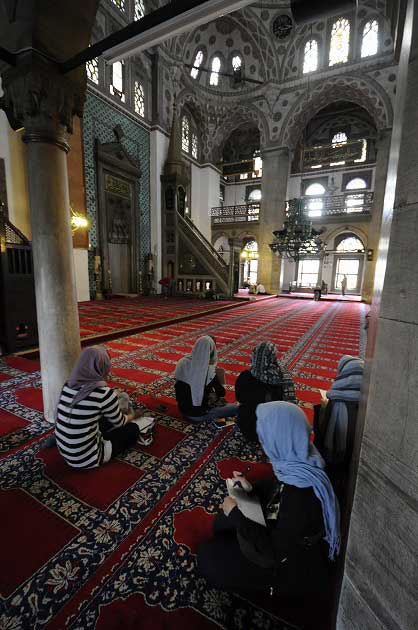 |
| Sketching at Yeni Valide Mosque in Uskudar |
|
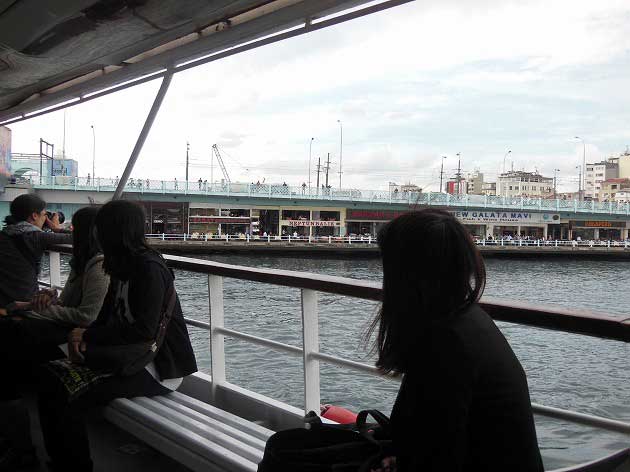 |
| Galata Bridge as seen from the sea
|
|
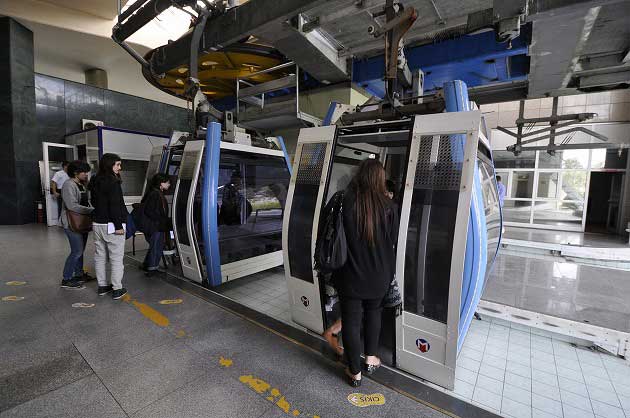 |
| Getting on a funicular in Eyup |
|
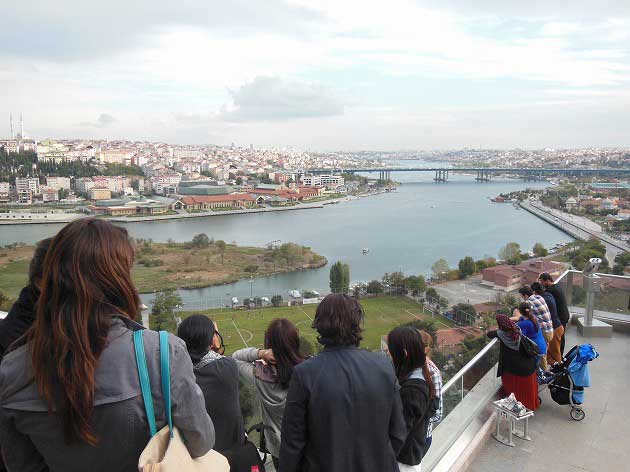 |
| Cityscape of Istanbul beyond the Golden Horn as seen from Pierre Loti |
|
 |
| Looking over Istanbul out of the Galata Tower |
|
| In the morning we prepared for the sketch exhibition at the hotel and at the university. In the afternoon we visited Istanbul led by Vice Dean Dr. Murat D?ndar and Research Assistant Sinem Kultur. To begin with we visited Yeni Valide Mosque, Uskudar, crossing Bosporus to the Asian side. Then returning to the European side by boat we went up the Golden Horn and arrived at Eyup located deep in the bay. Then we climbed up to the rise called Pierre Loti to have a view of Istanbul across the Golden Horn. Then we climbed the Galata Tower and had a view of Istanbul from another angle. Finally we walked along Istikl?l street seeing the town, doing shopping and having supper of simit (doughnut bread with sesame) before returning to the hotel by bus. |
|
|
|
Wednesday, October 10, 2012
Practical training of preservation and restoration work at KUDEB |
|
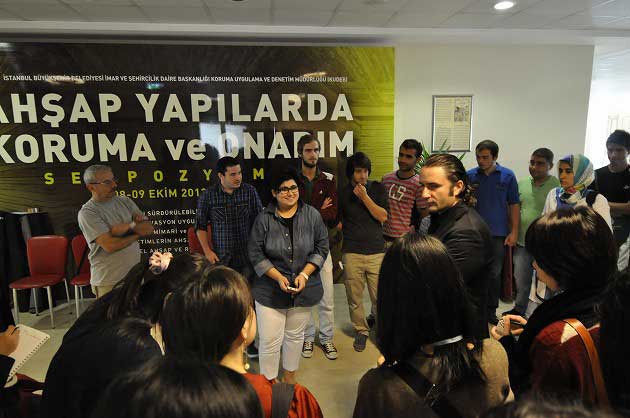 |
| Arriving at the municipal culture center where a symposium sponsored by KUDEB had been held until one day before. |
|
 |
| Students as observing a one-tenth scale framework model of wooden architecture under refurbishment prior to visit the site. |
|
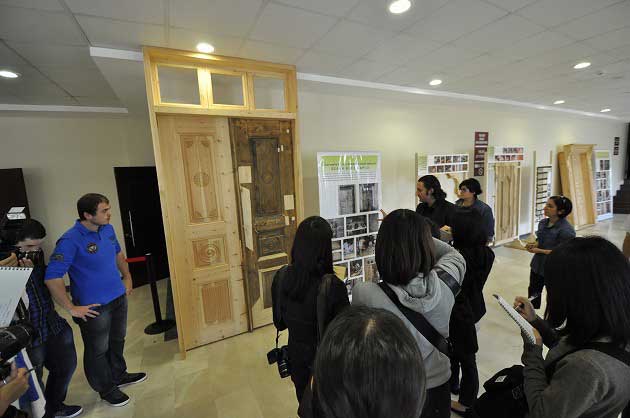 |
| Observing a refurbished door
|
|
 |
| Visit to the KUDEB atelier |
|
 |
| Pictures of the previouseICSA in Istanbul 2011' published in the KUDEB report are being shown to us. |
|
 |
| At the site of a wooden architecture that KUDEB is refurbishing. |
|
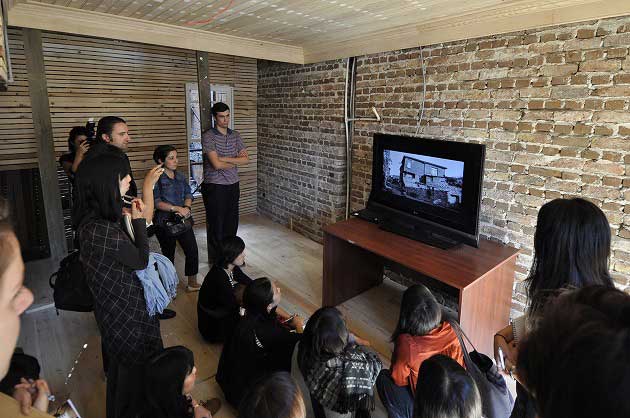 |
| Watching the video footage of refurbishment of the very wooden architecture we were in |
|
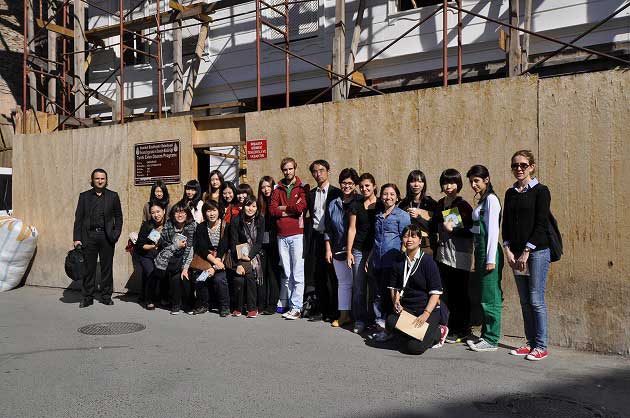 |
| Commemorative photo at the refurbishment site |
|
 |
| Visiting Suleymaniye Mosque |
|
 |
| Supper in the university hosted by Prof. Dr. Ahmet Eyuce, Dean of the Faculty of Architectural and Design |
|
| After the training conducted under combined effort of KUDEB (a municipal organization of Istanbul engaged in preservation and restoration of the houses and other structures) we visited S?leymaniye mosque led by Vice Dean Dr. Murat Dundar and Research Assistant Sinem Kultur.
To begin with we headed for the municipal cultural center, where a symposium had been held for two days until yesterday under the sponsorship of KUDEB. We received an explanation by the staff about the exhibits in the lobby of ex-symposium site including the pieces which we have made or repaired with the help of KUDEB staff such as lattice, door, steps or a framing model (one-tenth scale) of the wooden house under restoration. Then we moved to KUDEB at Suleymaniye mosque to visit the atelier with an explanation of a specialist Ms. Demet. After lunch, we visited the site of wooden house being restored by KUDEB to tour inside the house with an explanation by an architect Ms. Esra. The visit was concluded by watching the video footage of the present refurbishment work and commemorative photo taking in front of the wooden house. After the study course we visited S?leymaniye Mosque. In the evening we were invited to the supper hosted by Prof. Dr. Ahmet Eyuce, Dean of Faculty of Architectural and Design, which was held on the terrace of the university.
|
|
|
|
Tuesday, October 9, 2012
Practice at the tile atelier of Iznik Foundation; visit to wooden architectures in Soloz and Cumalikizik |
|
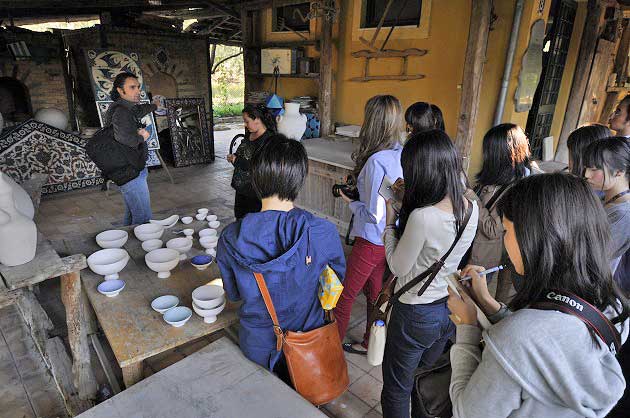 |
| Watching a traditional kiln at the tile atelier of Iznik Foundation |
|
 |
| Observing painting process of the tiles |
|
 |
| Students are practicing the tile painting in the same atelier that the artisans at the atelier use. A pattern is being press copied on the tile rubbing up the design against the tile surface using charcoal.
|
|
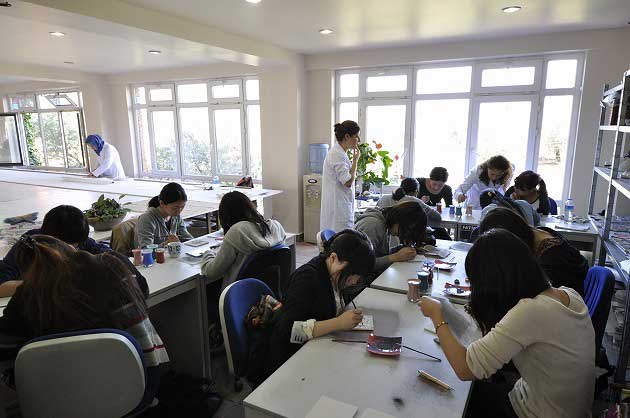 |
| Students as coloring the tiles |
|
 |
| Tiles after being colored |
|
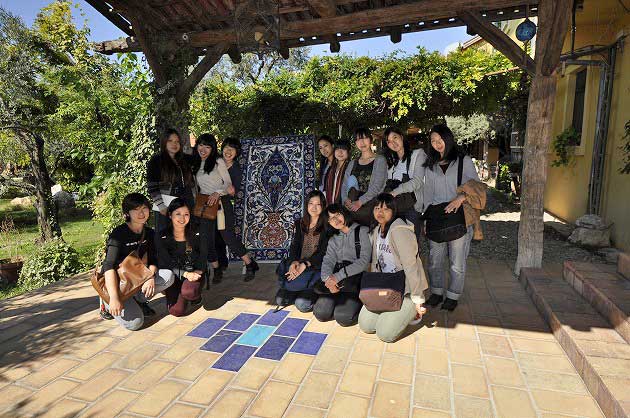 |
| At the entrance of the tile atelier |
|
 |
| Watching a wooden architecture in Soloz |
|
 |
| Watching streetscape of Cumalikizik |
|
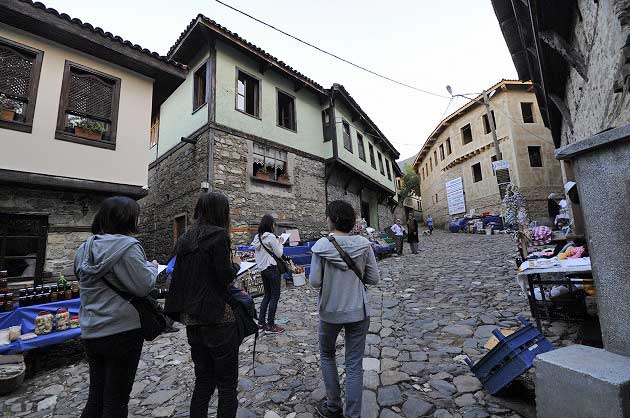 |
| Sketching streetscape of Cumalikizik |
|
 |
| Students as eating taken-out k?fte on the ferry on their way back. |
|
| @After the visit and practice at the tile atelier of Iznik Foundation, we visited two villages, S?l?z and Cumalikizik, to observe and sketch traditional wooden houses and streetscape. Vice Dean Dr. Murat D?ndar and Research Assistant Sinem K?lt?r of Bahcesehir university led us all day.
In the morning we visited the tile atelier and practiced painting on 12cm square Iznik tile with the help of artisans. After lunch in Iznik we visited S?l?z and watched the exterior of 4-storied wooden architecture. Then we visited Cumalikizik which inherits an old streetscape from the Ottoman Empire days, where we observed and sketched streetscape before returning to Istanbul.
|
|
|
|
Monday, October 8, 2012
Visit to Bursa |
|
 |
Bursa
Visit to Ulu Camii |
|
 |
| Sketching the interior view of Ulu Camii |
|
 |
Visit to Koza Han
Two-storied shop building surrounds a courtyard. True to its name Koza (cocoon) there are many shops which deal with silk products. |
|
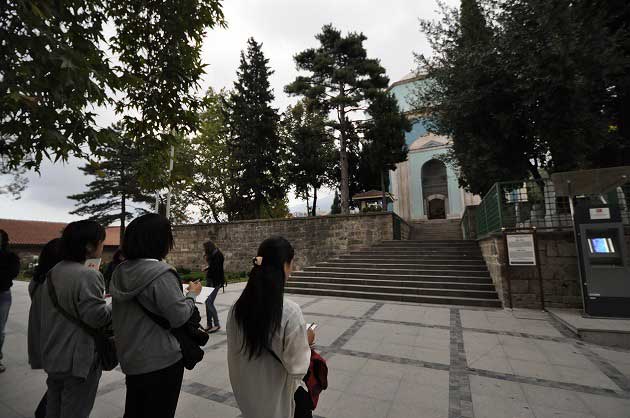 |
| Sketching the exterior view of Ye?il T?rbe (literally egreen tomb'), a mausoleum from the Ottoman Empire Period. |
|
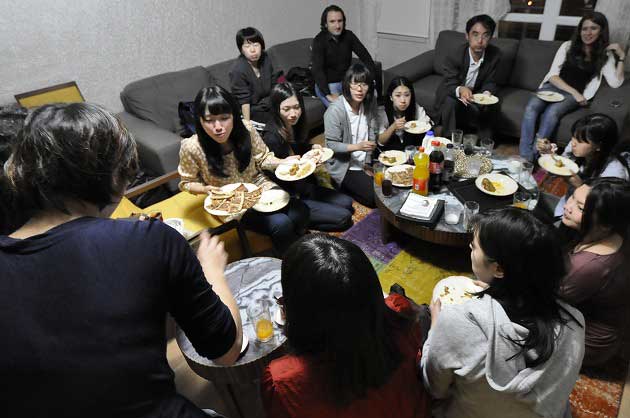 |
| Being treated with home-cooked dishes by BU students' mothers |
|
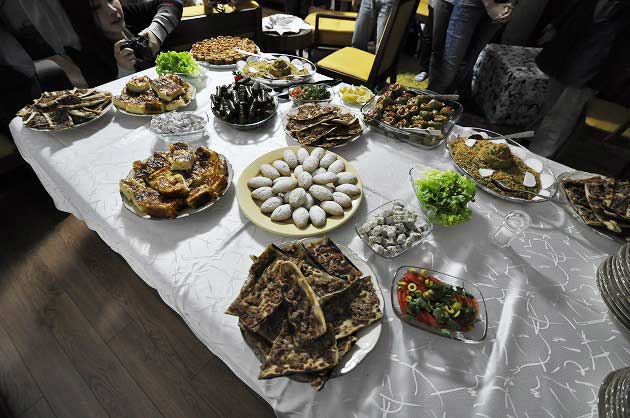 |
| Look at the varieties of dishes cooked by students' mothers! |
|
 |
| Commemorative photo with the families |
|
| Today we visited Bursa. Vice Dean Murat D?ndar and Research Assistant Sinem Kultur led us all day. In Bursa we visited Ulu Camii (literally eGrand Mosque'), Koza Han where two-storied shops stand surrounding the court yard, and Yesil Turbe (literally egreen tomb') where the soul of Mehmed I sleeps. In the evening, we were invited to the dinner at the student's home who has participated in ICSA in Japan 2012. Although so many staffs and students were invited (there were 17 of us) we were treated with varieties of Turkish cuisine and chai more than we could afford to eat them all. |
|
|
|
Sunday, October 7, 2012
Visit to Taksim Square, Buyuk Island |
|
 |
| Arriving at the ferry port for Buyuk Island |
|
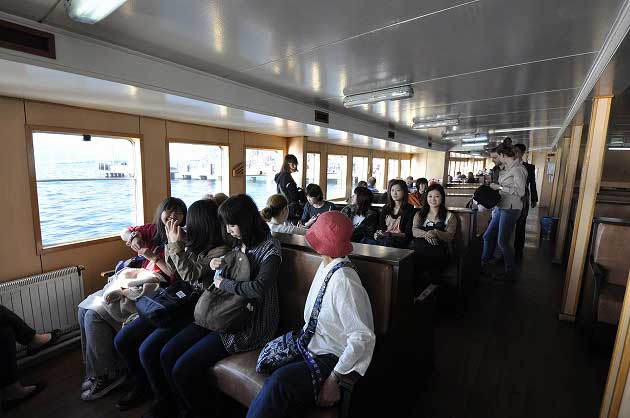 |
| Aboard the ferry |
|
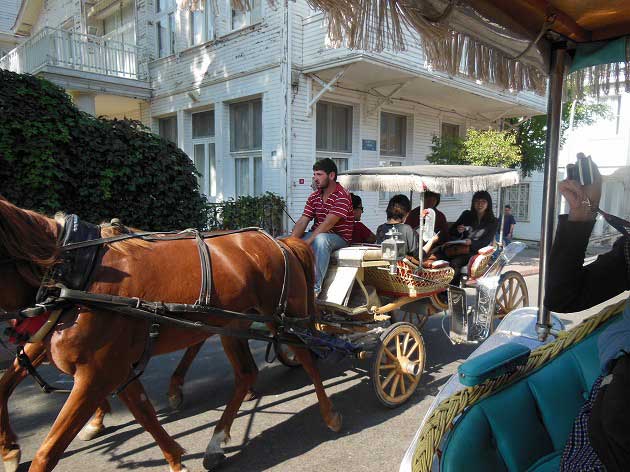 |
Students took a horse-drawn carriage.
Horse-drawn carriage, bicycle, walk are normal means of transportation here as the public diving is not allowed in the island.
|
|
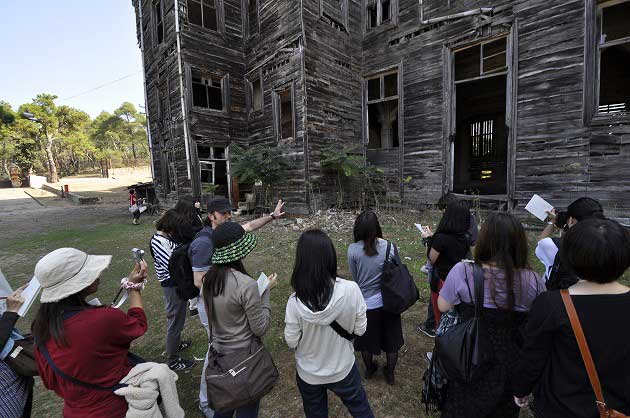 |
Greek Orphanage
Listening to the explanation by Dr. Murat Dundar
|
|
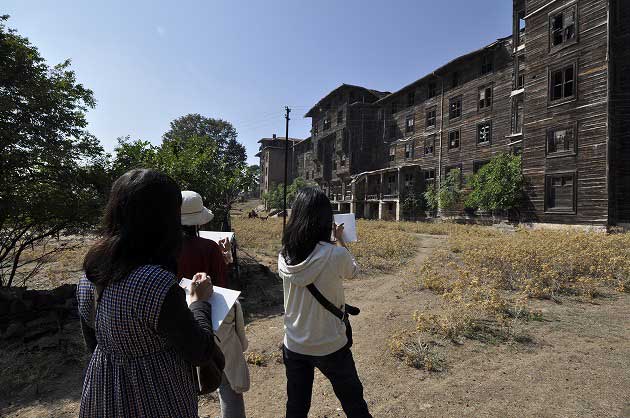 |
Greek Orphanage
Sketching the exterior view
|
|
 |
| Observing the streetscape of Buyuk Island |
|
 |
| Having mackerel sandwich for lunch at a restaurant by the ferry port |
|
 |
| Observing the Taksim Square |
|
 |
| Having supper at a restaurant famous for its kebab located near the Tunel station |
|
 |
| Taking the Tunel (subway) |
|
| We crossed Bosporus by ferry to Buyuk Island located in 1hr30minutes' distance from Istanbul and visited Greek Orphanage which is said to be the most massive of the Turkish wooden architectures. Vice Dean Dr. Murat Dundar and Research Assistants Belinda Torus and Sinem Kultur led us all day. Upon arriving at Buyuk we took a horse-drawn carriage and then walked to the Greek Orphanage reputed to be the largest wooden structure in Turkey and sketched it. Although the building was originally designed as a hotel in 1888, it had been used as a child welfare facility until about 1960 because the hotel failed to obtain a license to begin with. Thereafter the building has not been used and now it is seriously damaged with part of roof having been fallen down. Leaving the Greek Orphanage, we walked down the sloping road to have mackerel sandwich for lunch at a restaurant near the ferry port. We also observed streetscape of a nearby town before we took ferry to Istanbul. @In the evening we started from Taksim Square and walked westward the Istikl?l Street seeing street view. On the way we stopped by an off-road shopping mall, candy stores or bookstores. We had supper at a restaurant which is known for its kebab located near the tiunel station. After supper we took the Tunel. The Tunel was inaugurated in 1875, the oldest metro in Europe. It has no midway station and the line is very short. It takes only three minutes from end to end. Getting off at Karakoy Station we took a bus to return to the hotel. |
|
|
|
Saturday, October 6, 2012
Visit to Kaman Kalehoyuk Archeological Museum; Institute of Anatolian Archeology and Kalehoyuk Site |
|
 |
| Visiting the Museum of Archaeology at Kaman-Kalehoyuk |
|
 |
| Listening to museum's brief overview given by Prof. Omura at the entrance |
|
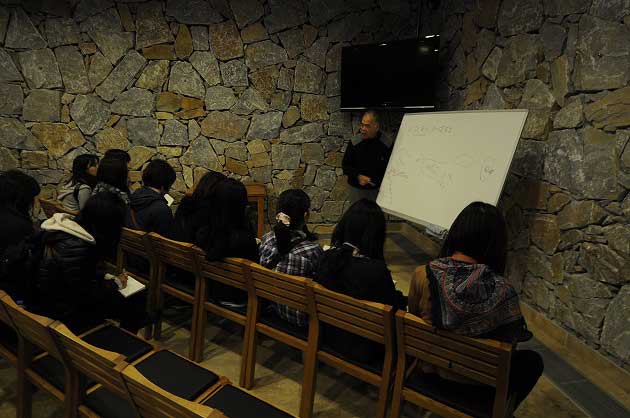 |
| Prof. Omura as commenting why we Japanese should be engaged in the excavation in Turkey |
|
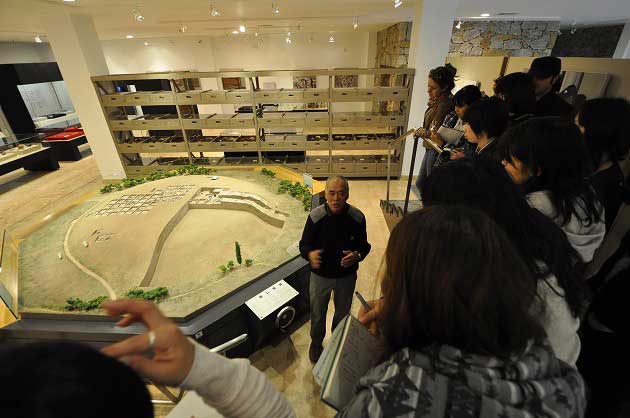 |
| Observing the miniature model of Kaman-Kalehoyuk Site |
|
 |
| Concept of gexhibitionh for the museum being explained |
|
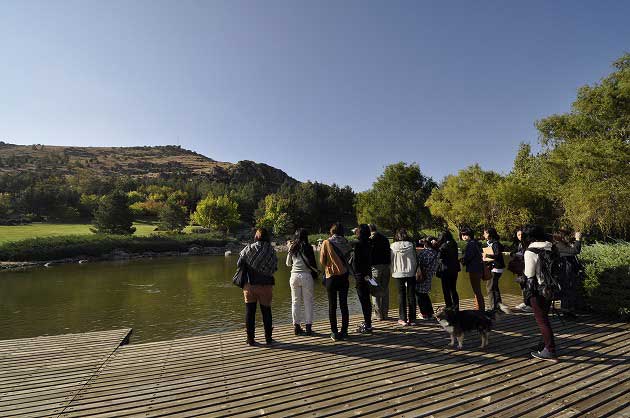 |
| Observing the Japanese garden |
|
 |
| In the library at the Japanese Institute of Anatolian Archaeology (JIAA) |
|
 |
| Watching the work at the laboratory in the JIAA |
|
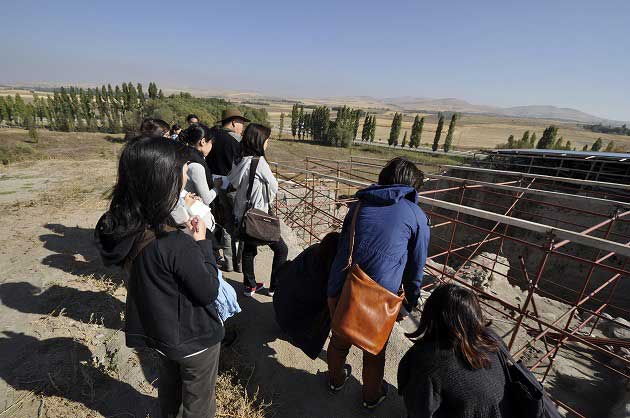 |
| Kaman-Kalehoyuk Site
Protective roof is being installed for the winter to come
|
|
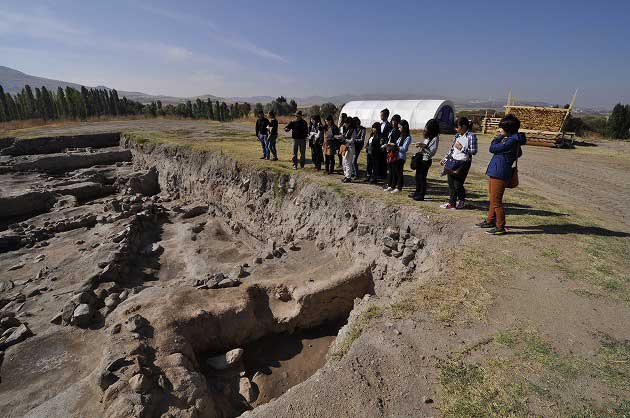 |
| Observing the Kaman-Kalehoyuk Site |
|
 |
| Commemorative photo beneath the Kaman-Kalehoyuk Site |
|
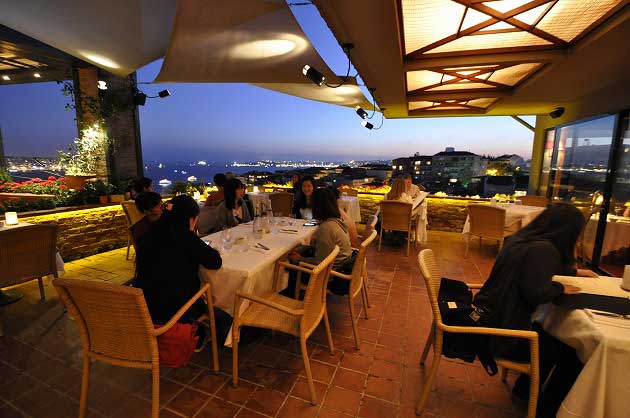 |
| Supper time |
|
| In the morning we visited the Museum of Archaeology at Kaman-Kalehoyuk, Japanese Institute of Anatolian Archaeology (JIAA) and Kaman-Kalehoyuk Site with the explanation of Prof. Omura, director of the Institute. Prof. Omura commentated during the tour the significance of Anatolia in understanding the world history and contemporary international society as well as the reason why Japanese should be involved in the excavation in Turkey or meaning of creating museums or preserving the archeological sites and difficulties with archaeological study. After that we left for Ankara Esenbo?a International Airport by bus to fly back to Istanbul. |
|
|
|
Friday, October 5, 2012
Cappadocia, Yassihoyuk Site |
|
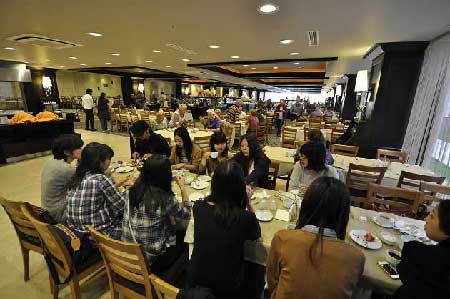 |
| Breakfast at the hotel |
|
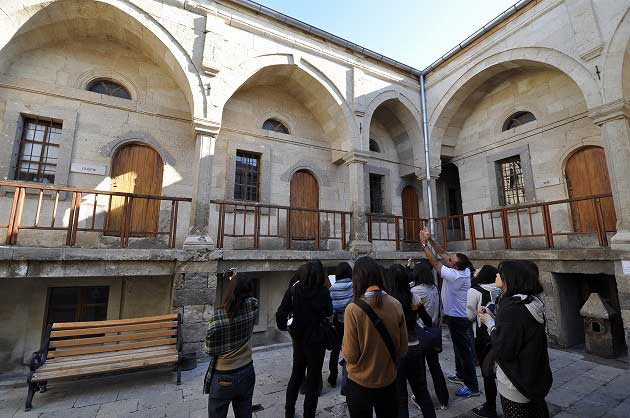 |
| Ex-Mustafa Pasa's theological seminary It is used as the senior college building today. |
|
 |
| Konstantin Eleni Church
A church for the Greek who once lived in this area
|
|
 |
| Pasabagi Valley
A view of juxtaposed mushroom rocks
|
|
 |
| Observing the guestroom at a cave hotel |
|
 |
| Sketching views from the terrace of a cave hotel |
|
 |
| Visiting Yassihoyuk Site |
|
 |
| The guesthouse attached to the Japanese Institute of Anatolian Archaeology (JIAA) |
|
 |
| Students joined the institute's meeting and listened to the report of the day's excavation results. |
|
 |
| Supper in the Institute's dining hall |
|
| Today we visited Cappadocia in the morning and Yassihoyuk site in the afternoon. In the morning, we visited Mustafa Pasa guided by Mr. Aiden, tour guide. The Greek once lived here and many buildings are of Greek style. We observed seminary, church and the streetscape. Then we appreciated the view of Cappadocia having the bus stopped in front of Camel rock and at Pasabagi Valley before visiting a cave hotel, where we had tea on the terrace. After lunch at a restaurant, we visited Yassihoyuk Site with the guidance of Ms. Masako Omura, researcher at the Japanese Institute of Anatolian Archaeology (JIAA) and head of this excavation site. Yassihoyuk Site is a buno site which expands 625m~500m and 13m high. At present the second layer from 2,260BC to 2200BC is being excavated. Then we visited the JIAA in Kaman. We were allowed to be present at the Institute's meeting. We were treated with supper and stayed at the accommodation attached to the Institute. |
|
|
|
Thursday, October 4, 2012
Cappadocia tour |
|
 |
| Departure from Istanbul Ataturk Airport |
|
 |
| Arrival at Nevsehir Cappadocia Airport |
|
 |
Visiting Kaymakli
Underground City It was a shelter for persecuted Christians. |
|
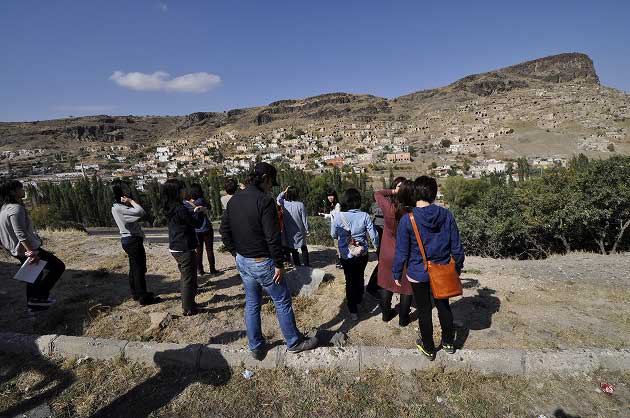 |
A view of villages of Gole
Houses seem as if they were adhered to the mountain side. |
|
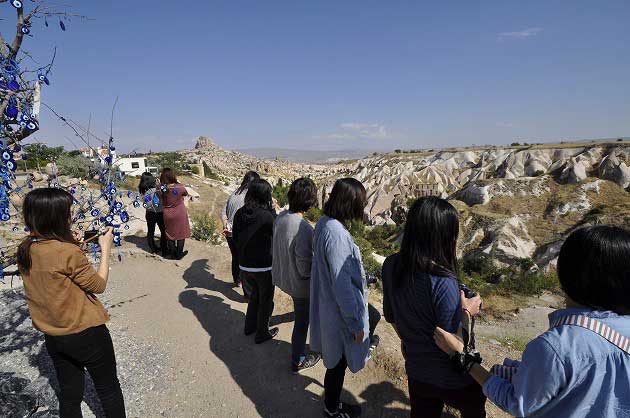 |
| A view of Pigeon Valley |
|
 |
| A view of U?hisar and surrounding area |
|
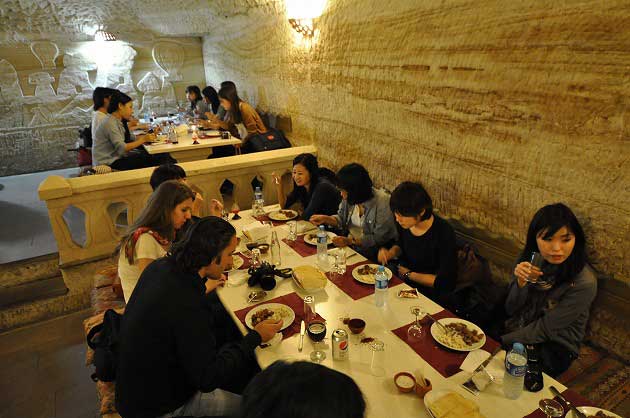 |
| Having lunch at a cave restaurant |
|
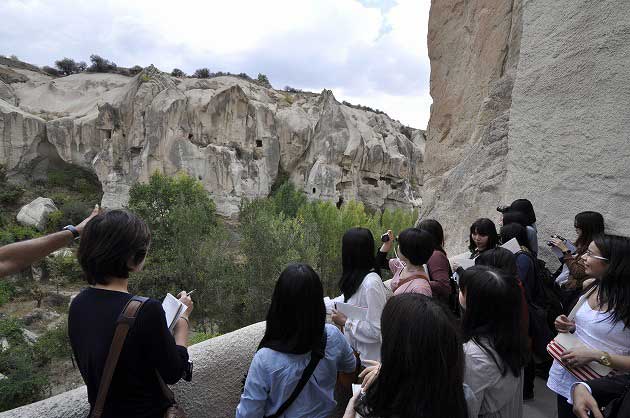 |
Goreme Open Air Museum
Students observed pigeon nests, which have been made to get fertilizer from them, etc. |
|
 |
| Commemorative photo at Goreme Open Air Museum |
|
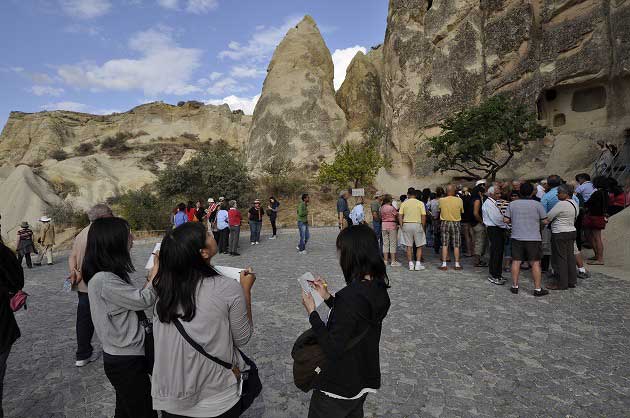 |
| Sketching at Goreme Open Air Museum |
|
 |
| The Hotel we stayed at. |
|
 |
| Having supper at the restaurant in the Hotel |
|
| Today, we visited Cappadocia. In the early morning we flew to Nevsehir from Istanbul. We toured by bus to see the views of Cappadocia stopping at various points in the order of Kaymakli Underground City, Gole Village which appears to be stuck to the mountainside, Pigeon Valley and a point with good view of Uchisar. We had lunch at a cave restaurant. In the afternoon, after visiting Apple Church (Elmali Kilise) and Snake Church (Ilanli Kilise) we spent sketching or seeing the sight on our own. |
|
|
|
Wednesday, October 3, 2012
Practice at the glasswork atelier |
|
 |
| Observing the facility of the glasswork atelier |
|
 |
| Watching the traditional kiln which was once used to manufacture glassware |
|
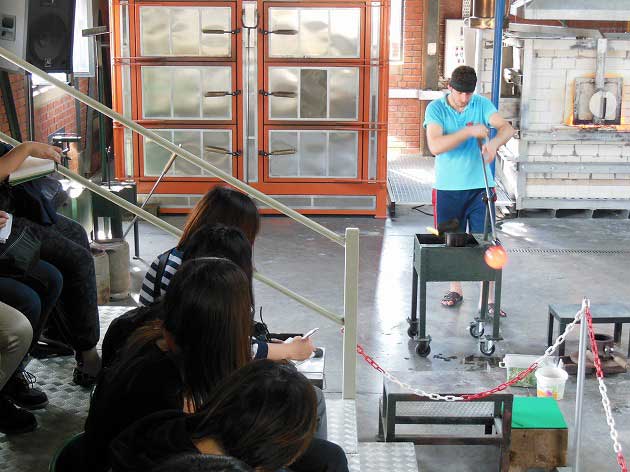 |
| Watching the glass blowing process |
|
 |
| Watching the glass blowing process |
|
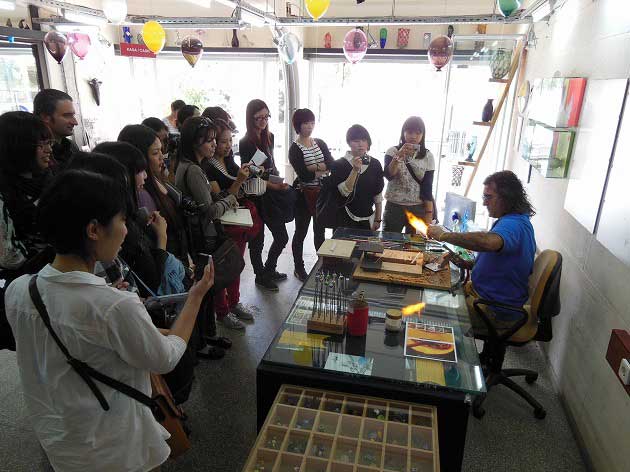 |
| Watching an artisan making a piece of glasswork of a dancing figure |
|
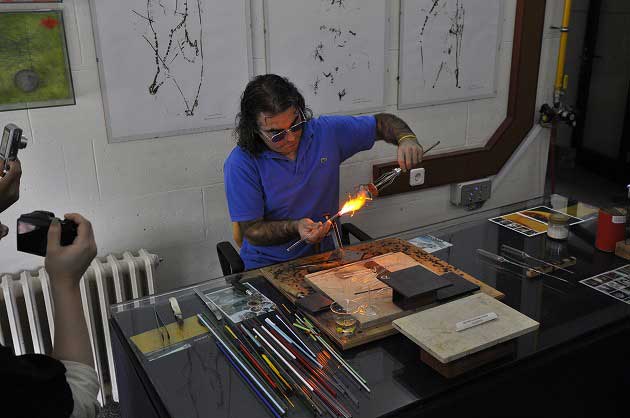 |
| A process in glasswork manufacturing |
|
 |
| Experiencing a glasswork process using pressure jet burner |
|
 |
| Commemorative photo with the artisan who guided us |
|
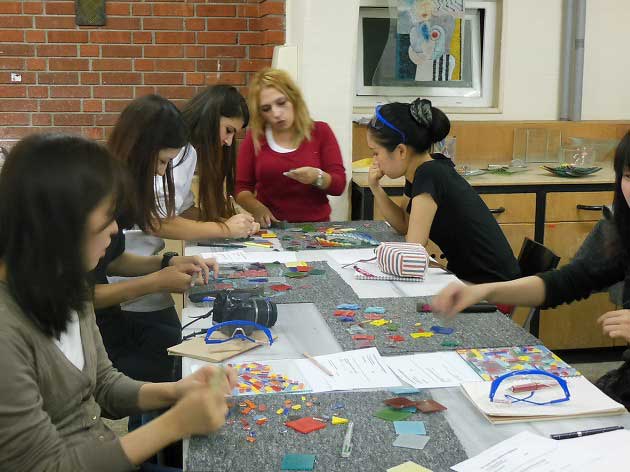 |
| Applying a decorating technique called fusion, which uses pieces of colored glass |
|
 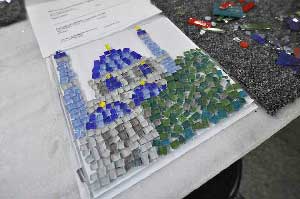 |
Pieces of work by the students
The final form of the work will be a dish or plate glass according to the studentsf choices. |
|
| We visited a glasswork atelier in Istanbul outskirts for observation and training. Vice Dean Dr. Murat D?ndar and Research Assistant Sinem Kultur led us all day. In the morning, at the atelier, we observed facilities such as material storage, traditional kiln and lounge and watched the process of glass blowing, and then we saw a video footage introducing the atelier. In the afternoon, we first observed the artisan making a piece of glasswork of a dancing figure. Then we experienced a glass work process using pressure jet burner made glass balls. Finally, we experienced a decorating technique called fusion which uses pieces of stained glass. |
|
|
|
Tuesday, October 2, 2012
Visit to the atelier for preservation and restoration at Dolmabahce Palace |
|
 |
| Listening to the Dr. Muratfs explanation of Dolmabah?e Palace |
|
 |
| Students are listening to the explanation how the stone is fabricated at the stonemason.
Although the technique has been handed down from one artisan to another, they told us the number of the successors is decreasing in recent years.
|
|
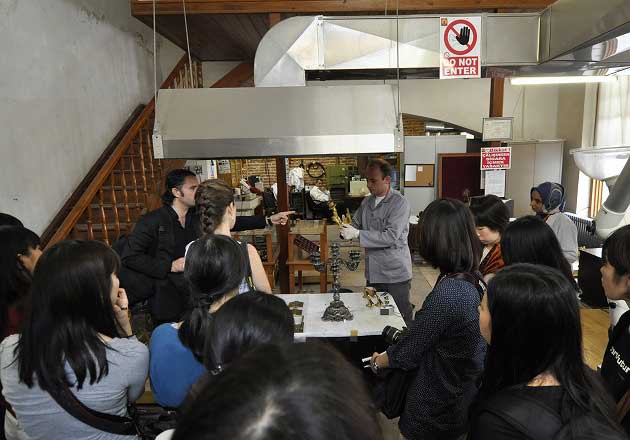 |
| At the metalwork atelier, students are listening to the explanation of the restoration where various combinations of different metals are used. |
|
 |
| At the stucco atelier, students are listening to the explanation about the refurbishment using colored plaster. |
|
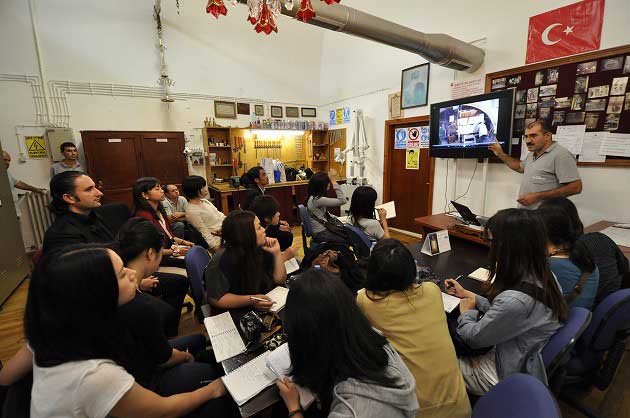 |
| Listening to an explanation using moving image about how the lead plate for the roof is manufactured.
Traditional manufacturing methods resulted in irregularity in thickness or quality and adverse effect on human body was also concerned. And the atelier developed a new manufacturing method on its own.
|
|
 |
| Having lunch at a caf? on the premise of the palace |
|
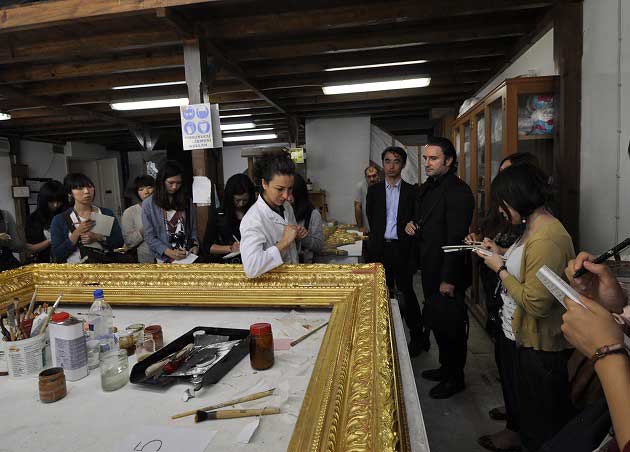 |
| Students are listening to an explanation about the restoration of the frames of the existing pictures in the palace.
We learned that the leaf gold is applied onto the frame surface using either water or oil depending on the type and the color of original leaf gold.
|
|
 |
| Commemorative photo was taken against the backdrop of Bosporus after the tour of the interior of the Dolmabah?e Palace. |
|
 |
| Students are saying thanks all at once to the person who took us around. |
|
| Today we visited Dolmabahce Palace to see preservation and restoration atelier and the interior of the palace led by Vice Dean Dr. Murat D?ndar and Research Assistant Sinem Kultur. In the morning, after visiting each atelier for masonry, metalwork and stucco before entering the room which had once been used to produce lead plate, where we were given an explanation of the use of stucco in the restoration work. And then, we were given an explanation using moving image about the traditional methods of manufacturing lead plate which had been adopted until 10 years before as well as about present methods and the way of roofing with lead plate. We had lunch in a cafe on the premise. In the afternoon, we visited the atelier where the picture frames were repaired before touring the interior of Dolmabahce Palace. |
|
|
|
Monday, October 1, 2012
Practical training of preservation and restoration at Yildiz Palace |
|
 |
| Students are observing a performance of manufacturing a wooden ornamental article |
|
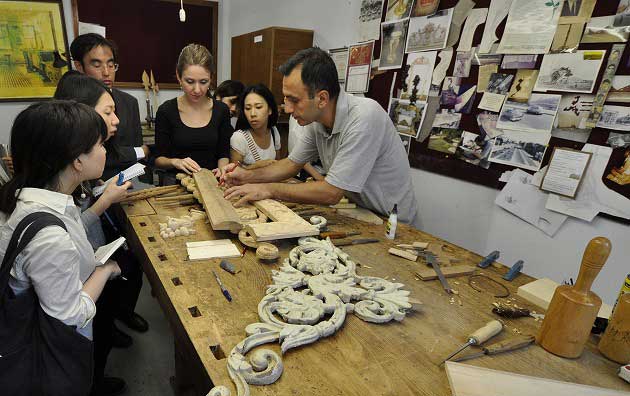 |
| Students are listening to an explanation about how to create and repair the wood engraving. About 50 types of chisels are used in such an engraving. |
|
 |
| Students are listening to an explanation about upholstery fabric.
Lining clothe is reinforced with a sheet of new clothe.
|
|
 |
| Students are listening to an explanation about curtains used in the palace. With the palace having large windows, the vertical length of curtains has to be 4.5m for normal windows and 6 m for largest ones. |
|
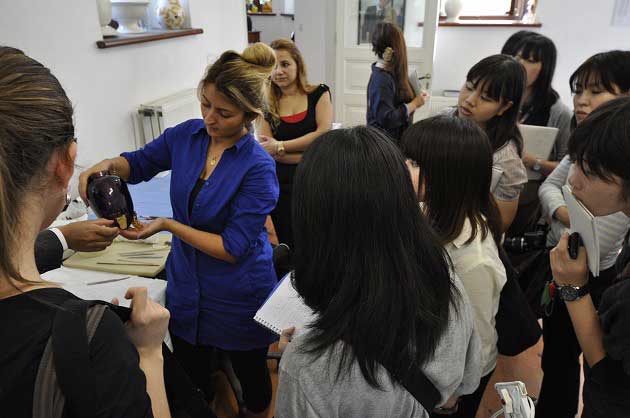 |
| Students are listening to an explanation about preservation and restoration of glass wares.
The color of the repaired part is intentionally changed a little different from the original ones so as to be distinguished as such.
|
|
 |
| A carpet being repaired |
|
 |
| Students are listening to an explanation about the repair of the interior decoration.
We learned that a chipped off part of a decorative article is first filled with plaster and then painted with clay so as the gold leaf can stick well onto the surface.
|
|
 |
| Students are listening to an explanation about how the wooden floor of the place is repaired. |
|
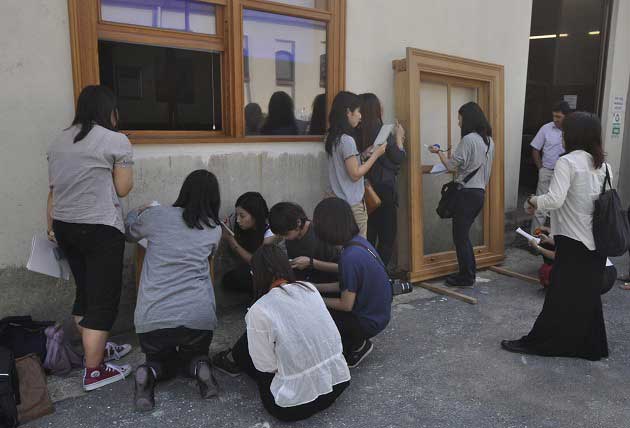 |
| Some students are making location survey of the double hung wooden window and the jalousie, while the others making sketches. |
|
 |
| Commemorative photo with the people in the atelier who helped us. |
|
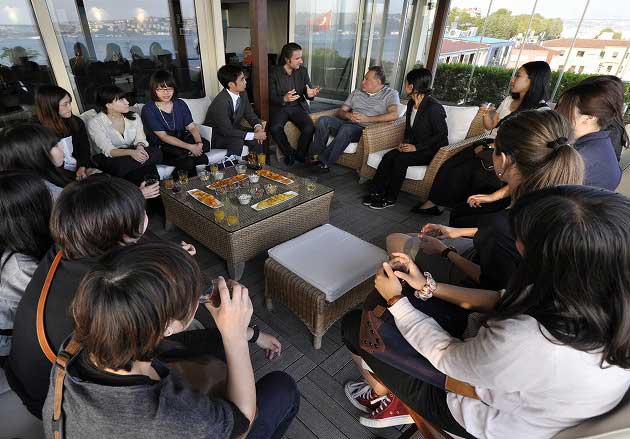 |
| A courtesy call on Dr. Envel Yucel, the Chairman of the Board of the Trustees of Bahcesehir University |
|
 |
| Donating a commemorative gift on the terrace of Chairman Envel Yucel. |
|
 |
| Every student is shaking hands with Chairman Envel Yucel. |
|
Today practical training of preservation and restoration was conducted at the Yildiz Palace. The atelier at the Yildiz Palace is engaged in the preservation and restoration not only for the articles in Dolmabahce Palace and other Turkish palaces, but also for the interior decorative articles or fixtures from Ottoman Empire period which are located over the world. In the morning, we visited plural atelier and observed the processes of dismantling and fabrication, framing and paint finishing of furniture, manufacturing of wooden decorative articles, as well as the atelier for sculpture and atelier for ornamentals. Finally we practiced location survey of fixtures and sketching in two separate teams.
The practice having finished we paid a courtesy call on Envel Yucel, the Chairman of the Board of the Trustees of Bahcesehir University. In the evening we visited Besiktas district of Istanbul, where we strolled the town and had supper. |
|
|
|
Sunday, September 30, 2012
Visit to Edirne |
|
 |
|
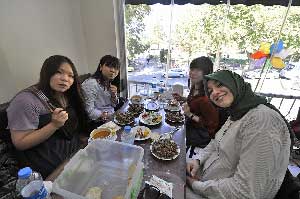 |
| Departing for Edirne by bus |
|
At a restaurant near Selimiye Mosque?liver dish for lunch |
|
|
 |
| Sketching the exterior view of Selimye Mosque |
|
 |
| Dr. Murat Dundar as commentating on Selimye Mosque |
|
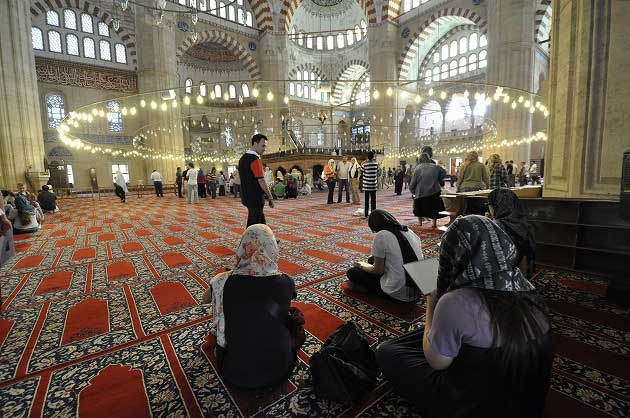 |
| Sketching the interior view of Selimye Mosque |
|
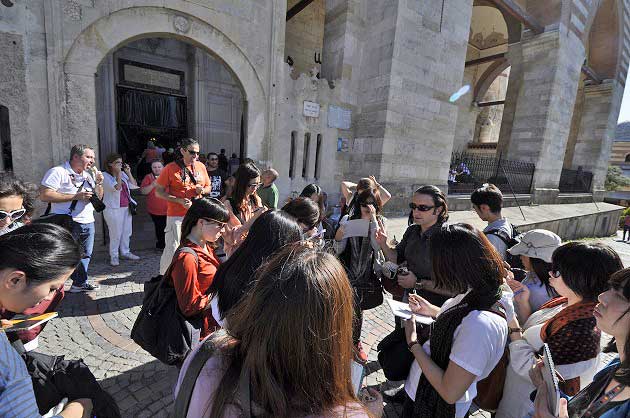 |
| Dr. Murat Dundar as commentating on Eski Camii |
|
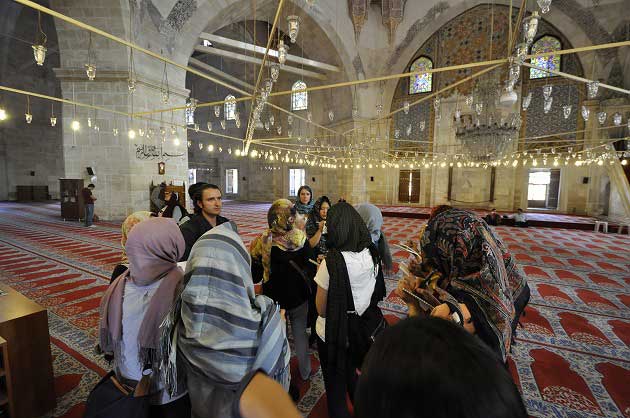 |
| Dr. Murat D?ndar as commentating on Uc Serefeli Mosque |
|
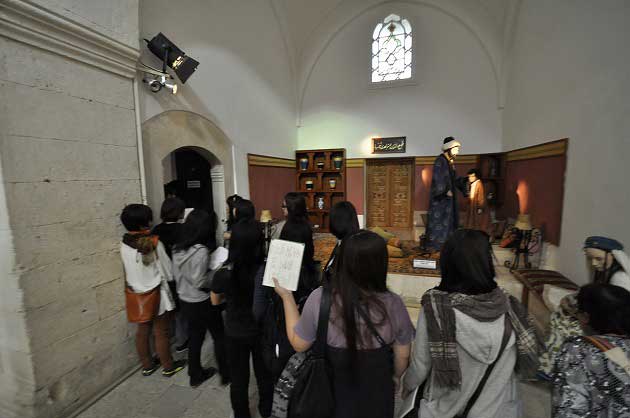 |
| Visit to Edirne Bayezid II Kulliye Health Museum |
|
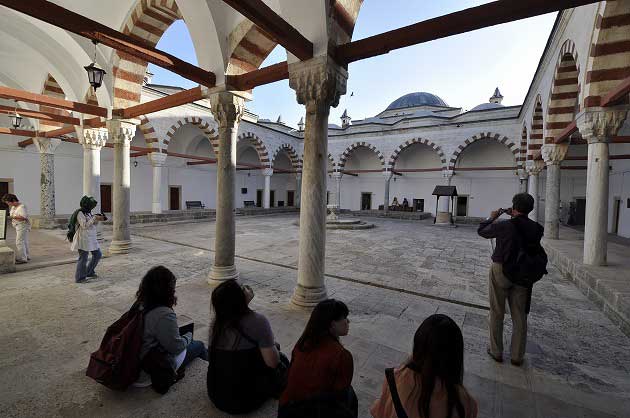 |
| At the courtyard in Medical Museum |
|
| Today we visited Edirne located in the west at a distance of three hours by bus. It is a town bordering with Greek and Bulgaria. Vice Dean Dr. Murat D?ndar and Research Assistant Sinem Kultur led us all day. Edirne is said to have its origin in a town made by order of Emperor Hadrian of Roman Empire, and it was once called Hadrianopolis or Adrianople. It was once the capital of Ottoman Empire. Before and after lunch, we visited Selimie Mosque, a mosque which is said to be the magnum opus of the architect Sinan and we made sketches of its exterior and interior views. Then we visited Eski Camii, the oldest of the mosques in Edirne, Uc serefeli Mosque with four minarets with four different forms and the Bayezid II Kulliye Health Museum, where music therapy was once being applied for psychiatric care. We had supper at a service area on the return trip. |
|
|
|
Saturday, September 29, 2012
Visit to Historic Areas of Istanbul |
|
 |
|
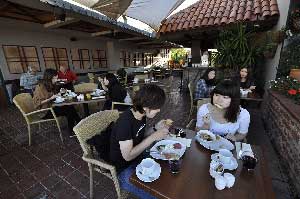 |
| Breakfast at the hotel |
|
Taking breakfast on the terrace |
|
|
 |
| View from the terrace
Bosporus
|
|
 |
| Dr. Murat Dundar as commentating on Hagia Sophia |
|
 |
| Sketching at Hagia Sophia |
|
 |
| Commemorative photo on the terrace at Topkapi Palace |
|
 |
|
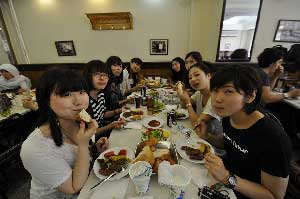 |
| Visit to Topkapi Palace |
|
Having Kofte for lunch at a restaurant near Sultan Ahmet Square |
|
|
 |
| Sketching Sultan Ahmet Mosque (Blue Mosque) |
|
 |
| Visiting Sunken Palace (Yerebatan Sarayi) |
|
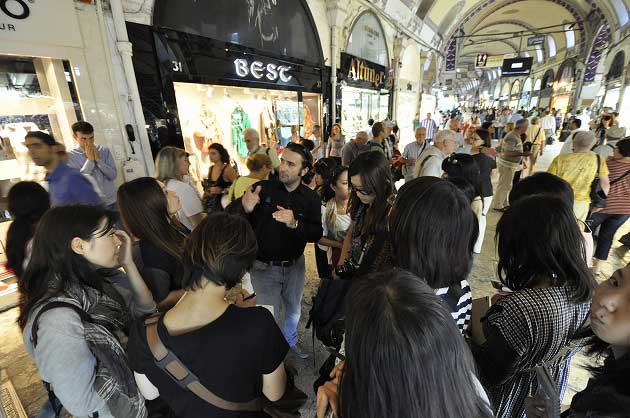 |
| Visiting Grand Bazaar |
|
 |
| Sketching external view of Hagia Sophia |
|
 |
| Dr. Murat Dundar as commentating on the history of Sultan Ahmed Square |
|
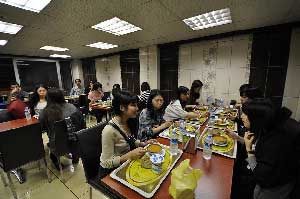 |
| Having supper at a lokanta (eating house) near the university |
|
| We toured Historic Areas of Istanbul all day. Istanbul is one of worldfs most outstanding historical cities. We were led by Vice Dean Dr. Murat D?ndar and Research Assistants Sinem Kultur and Belinda Torus of Bahcesehir University. In the morning we visited the greatest of all Byzantines, Hagia Sophia, and made sketches of it. Then we visited Topkap? Palace, where sultans of Ottoman Empire resided. In the afternoon we visited Sultan Ahmed Mosque called eBlue Mosquef, Sunken Palace (Yerebatan Saray?), Grand Bazaar, Sultan Ahmed Square to view and sketch them. We had supper at a lokanta (eating house) near the university. |
|
|
|
September 27-28, 2012
Visit to Bahcesehir University |
|
 |
|
 |
| At Kansai International Airport |
|
To Istanbul via Dubai International Airport |
|
|
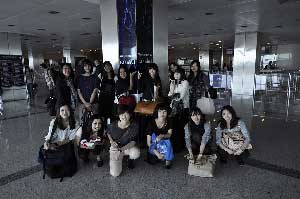 |
|
 |
| Arrival at Istanbul Ataturk International Airport |
|
Heading to Bahcesehir University from the airport by a microbus |
|
|
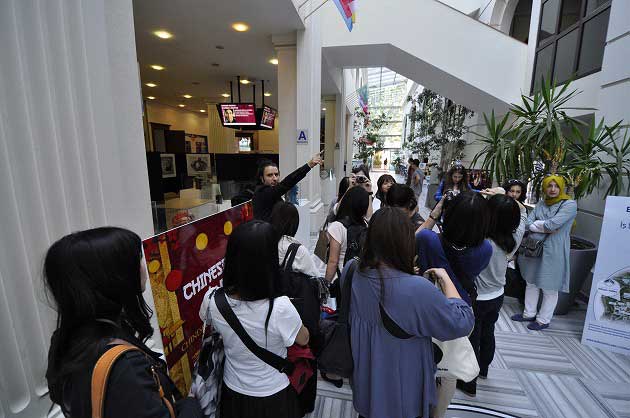 |
| Dr. Murat Dundar, vice dean of the Faculty of Architecture and Design, guiding the students from Mukogawa Womenfs University through the campus of Bahcesehir University |
|
 |
| Mr. Envel Yucel, the chair of the board of the trustees of Bahcesehir University, in the center of the photo, with students from Mukogawa Womenfs University |
|
 |
| Making a courtesy call on Prof. Dr. Senay Yalcin, the president of Bahcesehir University |
|
 |
| Giving a gift to Prof. Dr. Senay Yalcin to mark the occasion |
|
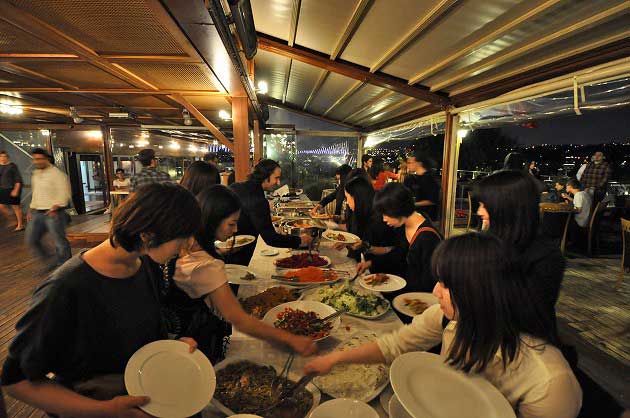 |
| Having a dinner at the University |
|
| >>2011 >>2010 |
| Hotel where members of ICSA in Istanbul 2012 were staied |
 |
| Appearance |
|
 |
| Guest room |
|
| >>TOP |
Copyright 2005-2012 Mukogawa Women's University.All rights reserved.
|






























































































































































